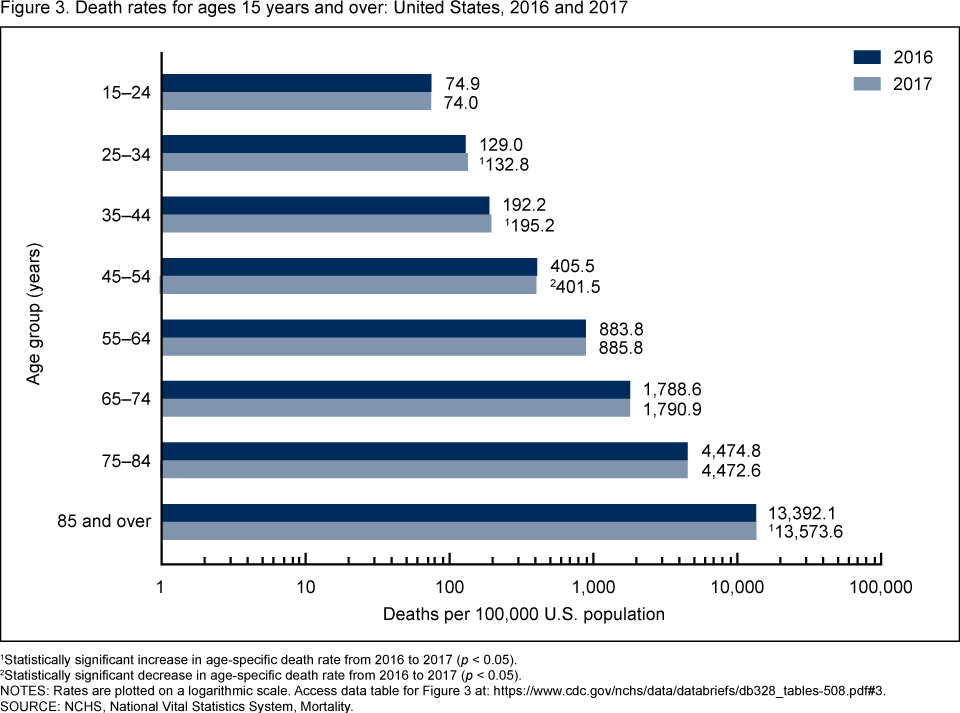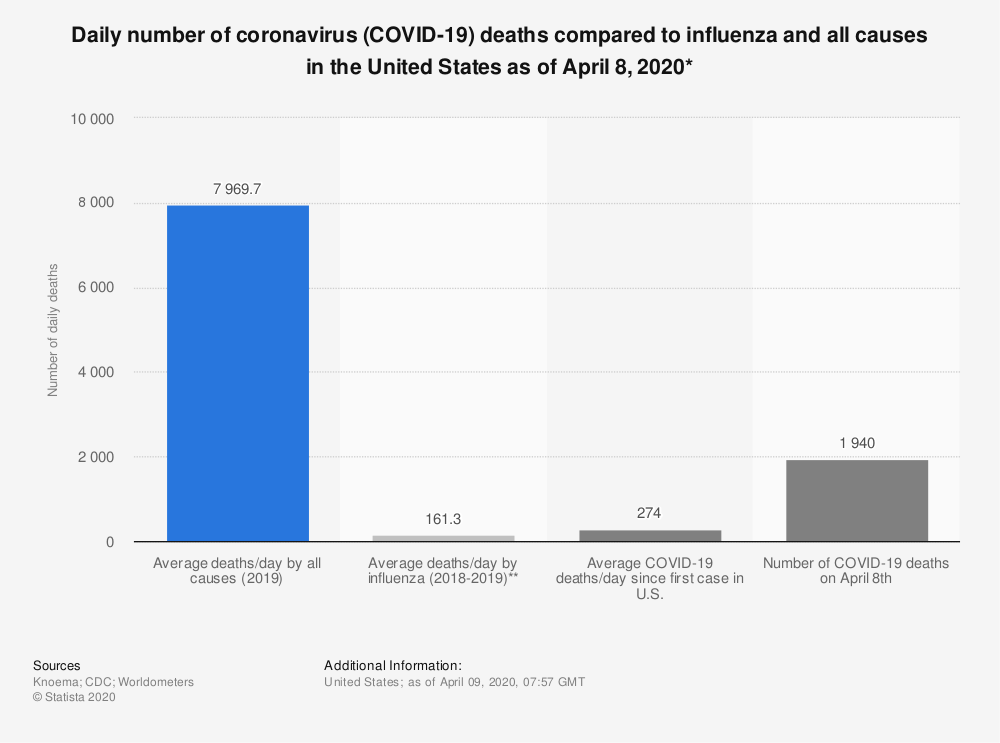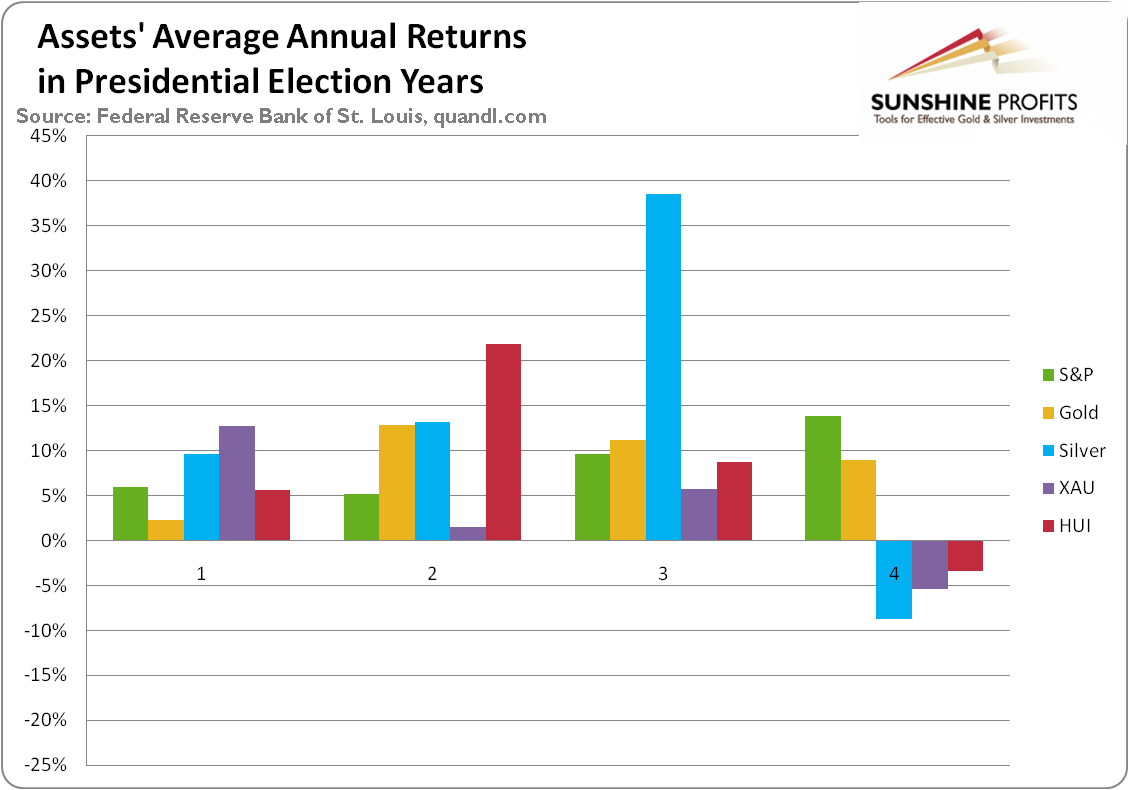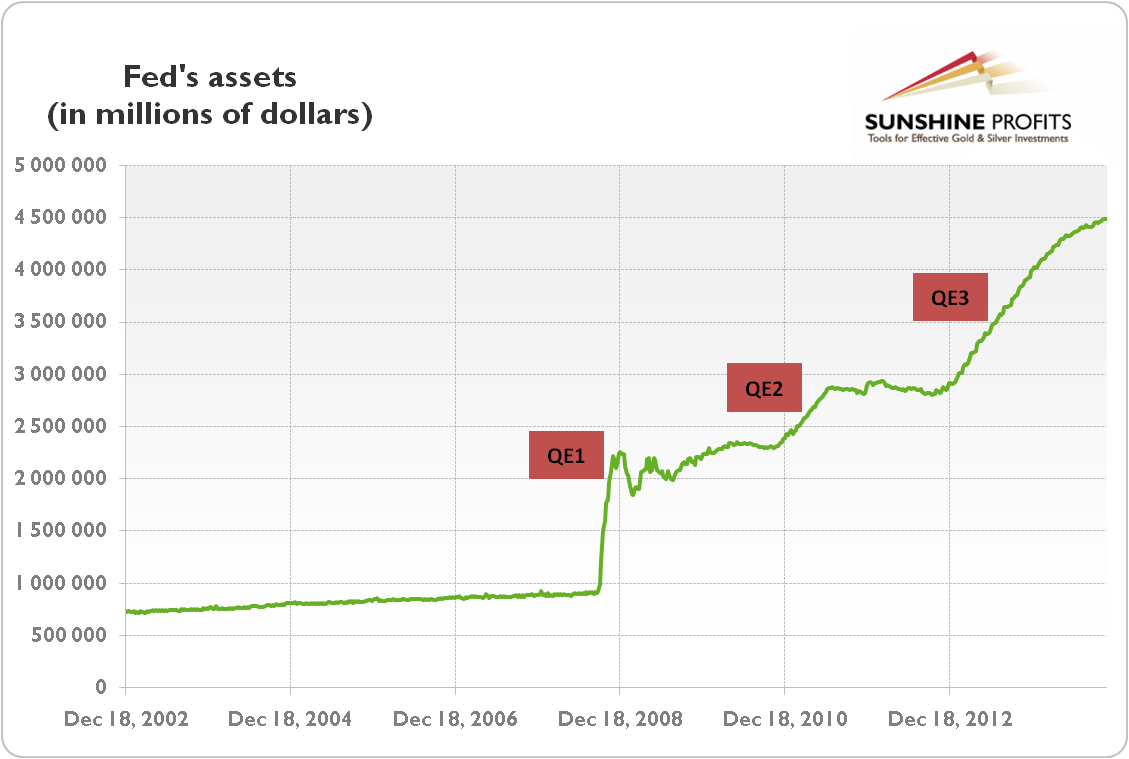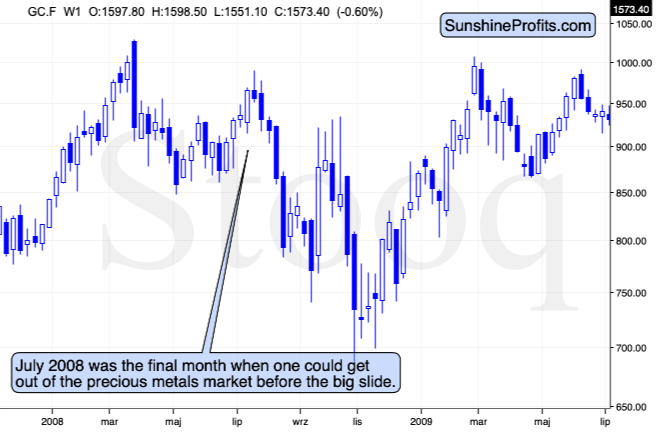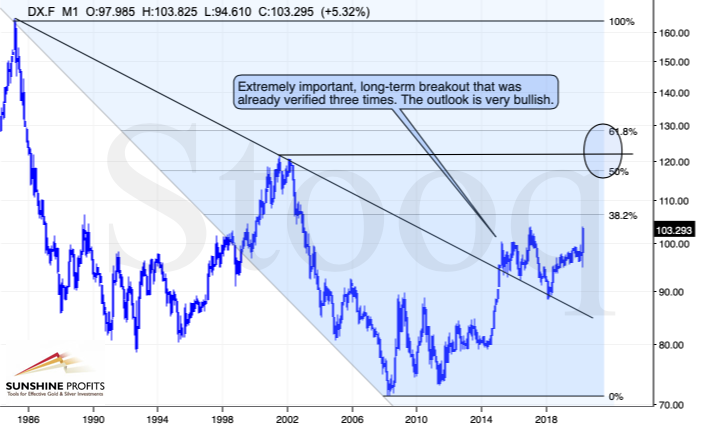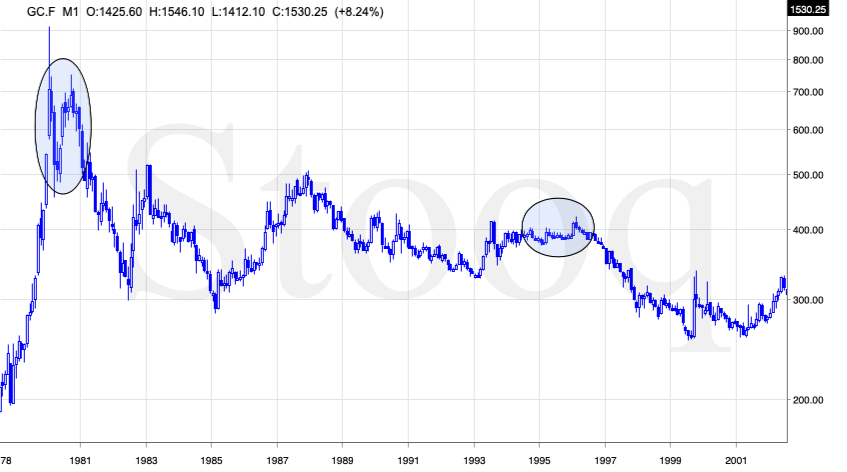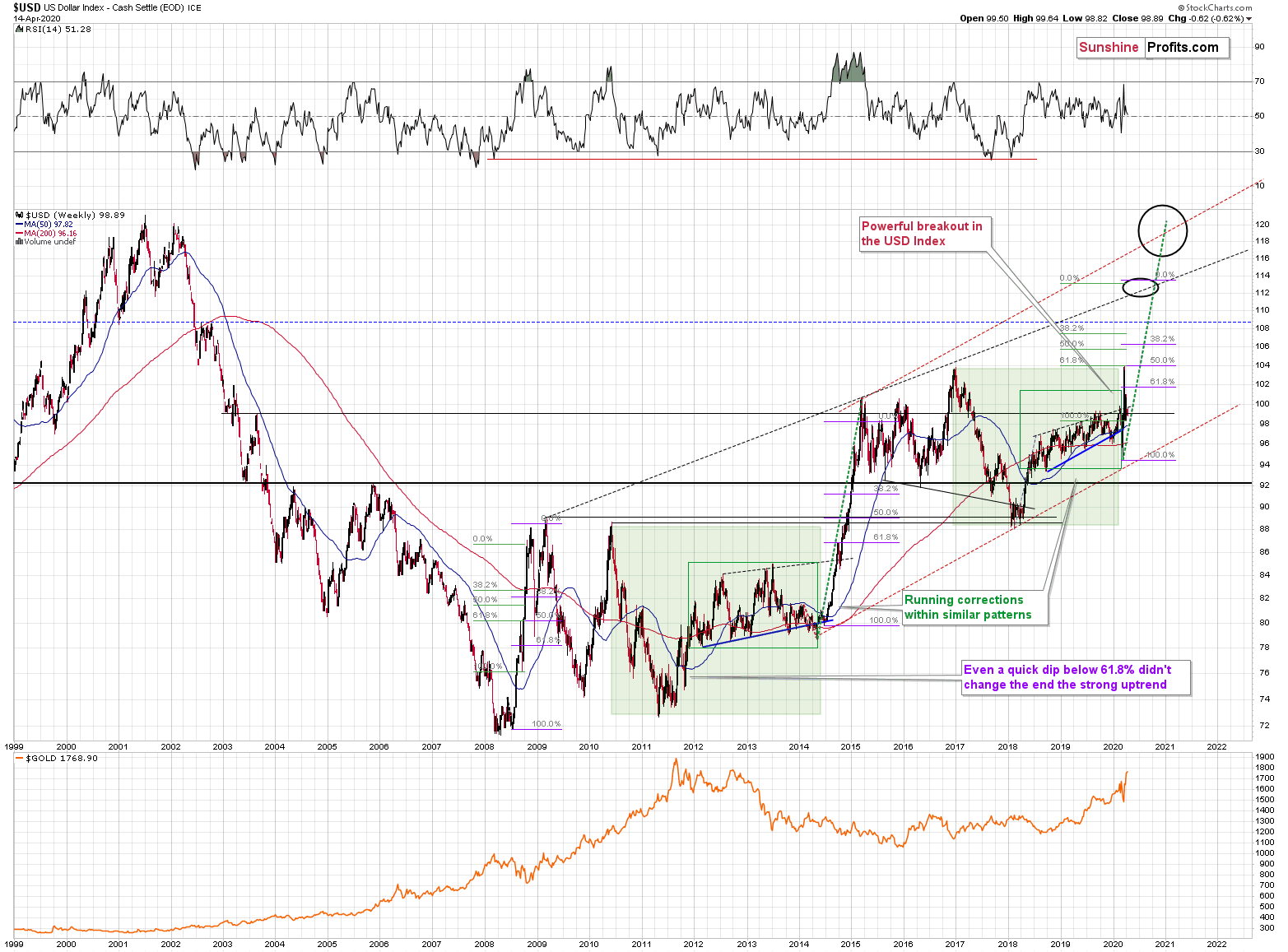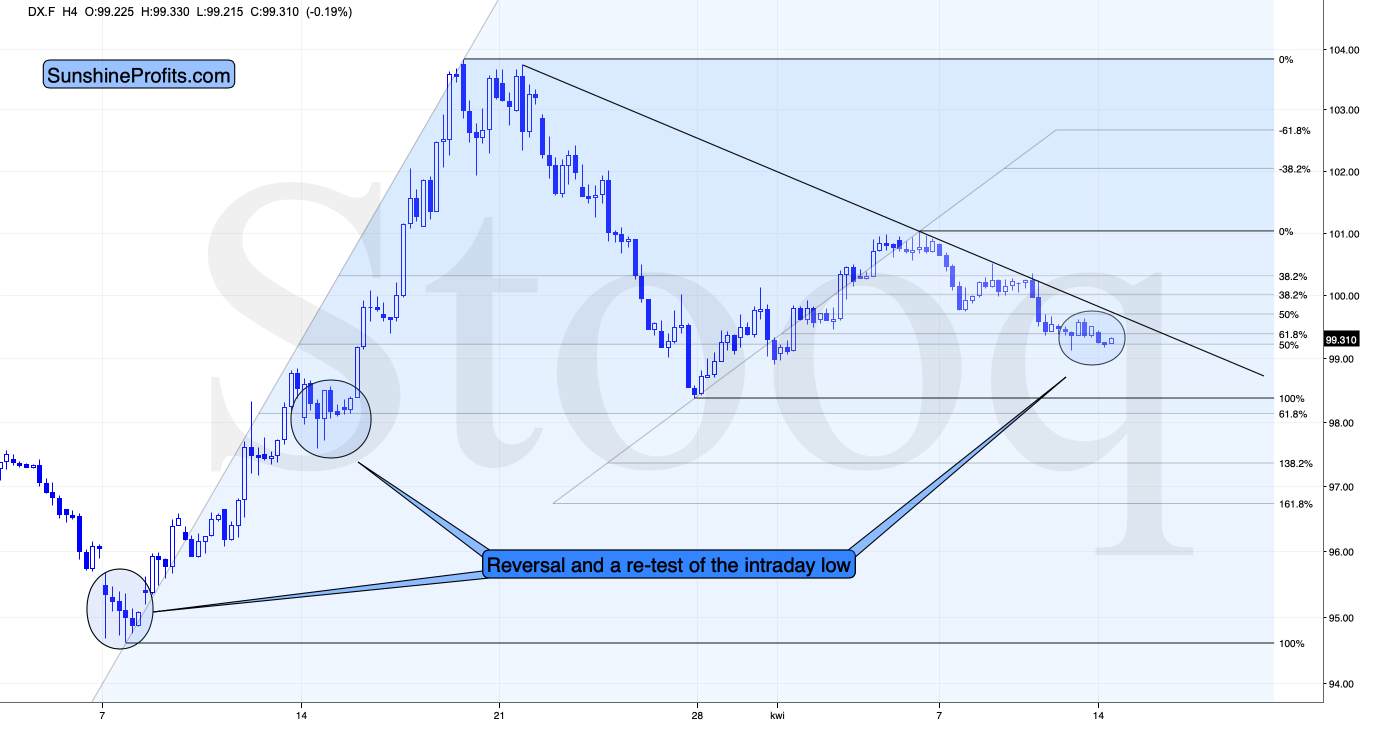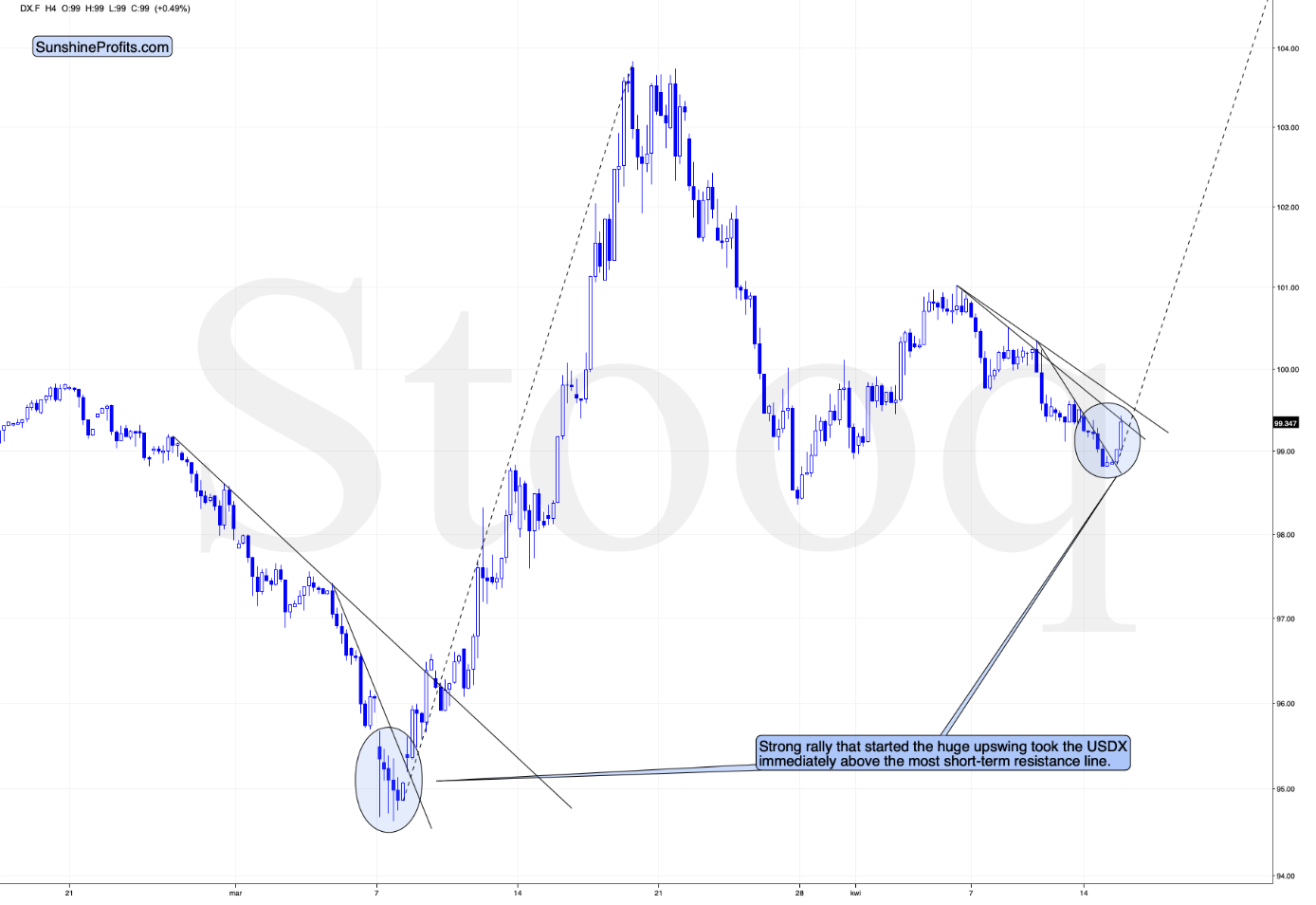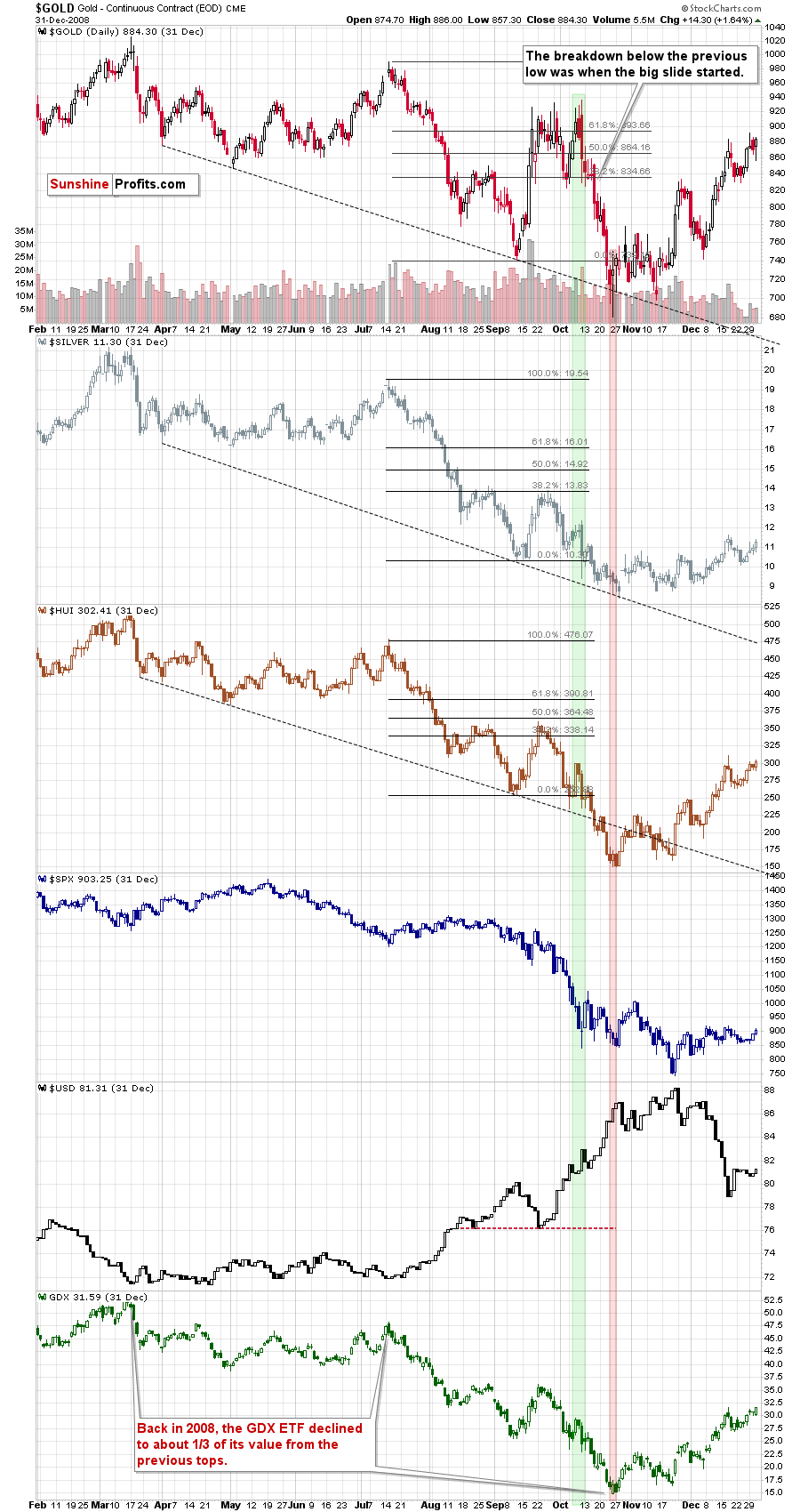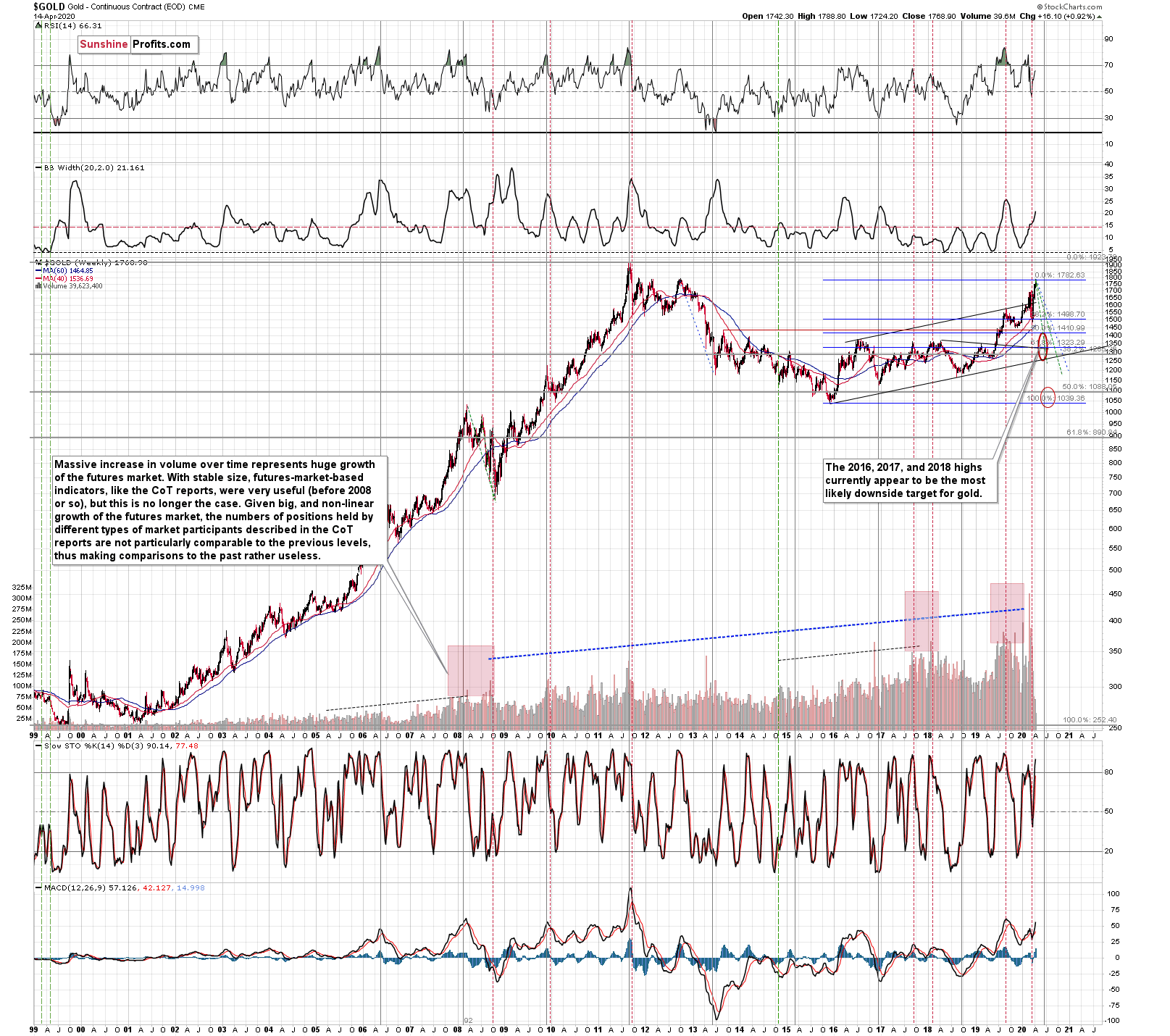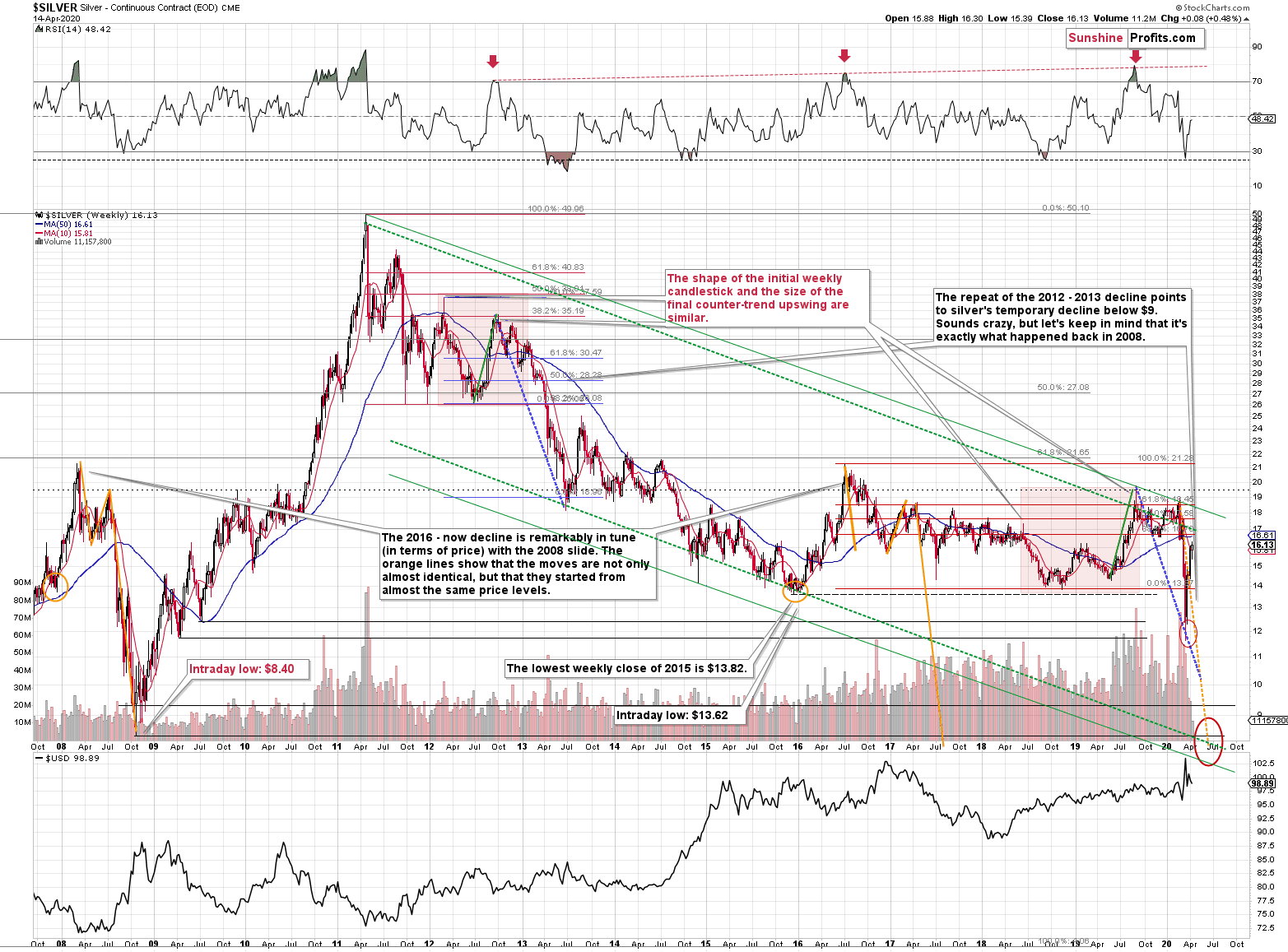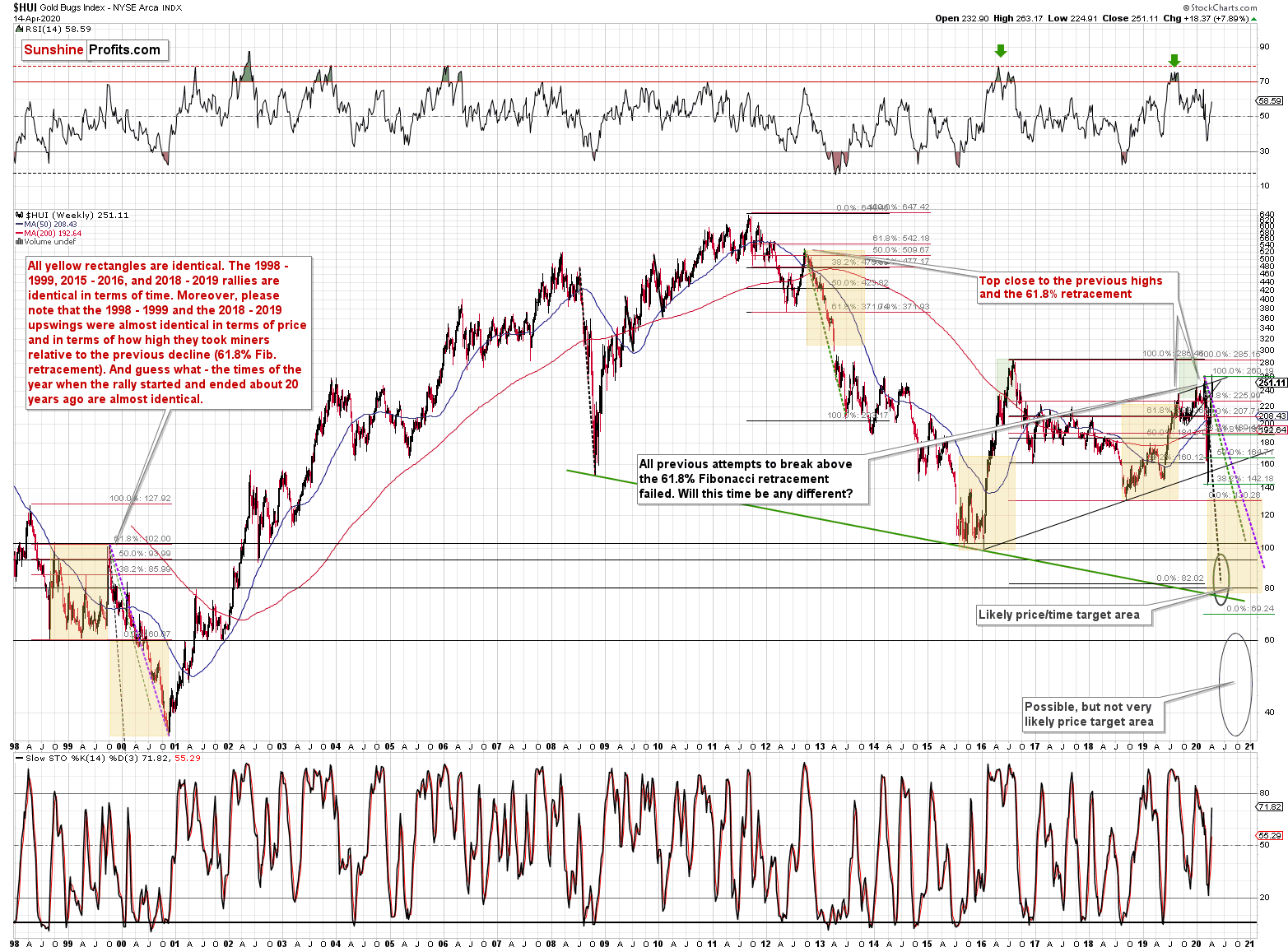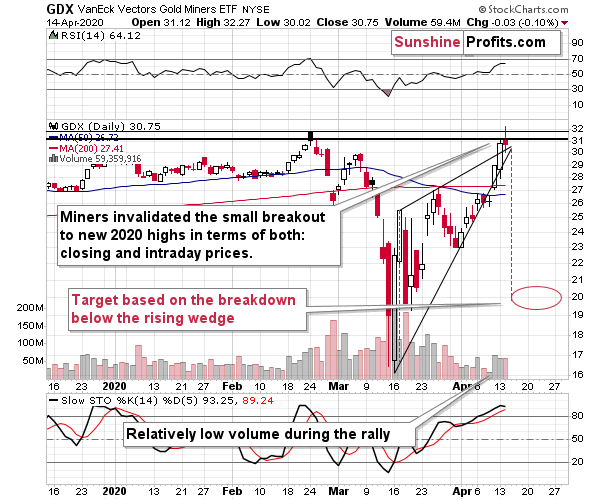Gold Investment Update - It's Ready, Steady, Go for the PMs
Briefly: Outlook for the precious metals market remains bearish for the following few weeks, and bullish for the following months and years.
Welcome to this week's Gold Investment Update.
This week the schedule is different, as we sent out an early Special Alert on Saturday.
Even though it might seem to be the case, the most important analogies and long-term trends didn't change during the previous 1.5 weeks and most of our previous extensive comments still remains up-to-date in general. However, as far as the details of the 2008 - 2020 price link are concerned with regard to the next several days, they require an update.
As it is the case usually, we will quote last week's comments while updating everything that needs to be updated or changed. In the end, the entire analysis that you'll read below is up-to-date at the moment of publishing. The parts that we didn't change (or changed only insignificantly) since last week, will be put in italics.
Let's start with the Covid-19 update.
COVID-19 Revisited
When we posted our previous flagship weekly analysis, the official US Covid-19 cases were at 338k. At the moment of writing these words, they are approximately twice as big - at 609k. The official death toll used to be about 10k, and right now it's at 26k.
People know that this is serious, but they don't fully grasp the extent yet. In particular, the economic implications. Once they do, the real panic will kick in, and we'll see price moves bigger and more profound than we saw in 2008. At least that's how we see it.
Why? Generally, our take on the situation didn't change since last week, so quoting our previous analysis, seems appropriate.
The situation in the world is unlike anything we've seen in the last few decades. In terms of the total death count it's still not much more of a deal than regular flu, but the problem is that what we see right now it's just the very tip of the iceberg. An iceberg that is not only under water, but also almost entirely beyond horizon.
Regardless of the way the situation is handled, it'll quite probably trigger further weakness in the US stock market.
Based on last week's developments, it seems that people might prefer the US dollar as a safe haven of choice - initially. After all, gold won't be used as money during the Covid-19 outbreak - electronic payments don't transmit viruses in general, while physical objects, like gold bars or coins - do. Consequently, the USD Index seems likely to soar in the following weeks after all.
As that happens gold is likely to slide.
But.
Once the focus on liquidity and raising cash (getting out of everything) subsides, people will realize that "it's the 70s all over again". Not because of oil shocks, but because of the stagflationary results. Some will anticipate what's likely to happen and they will buy gold. Some others will probably buy silver. And some will buy gold and silver miners that will have been hammered very hard. In one way it's like the 70s, but in another way - more technically - it's like 2008. Just like back then, gold is likely to rise back up like a phoenix reborn and rising from the ashes.
The mortality rate is between 0.5% and several percent, depending on how well prepared the health system is in a given country. Let's say that the mortality rate in the US will be 0.5%, which seems to be a conservative assumption. Given the delay in implementing decisive actions, a lot of people already are infected, and much more will become infected in the following days and weeks. Ultimately it could spread to, say 20% of the US population. And we're being conservative here - there are statistical models that point to about 50%-70% infection rate in the end.
With the US population at 327 million, this means that 327,000,000 * 20% * 0.5% = 327,000 Americans are likely to die from the Covid-19.
And what if the numbers were not that conservative? 1.5% mortality rate and 40% infection rate?
327,000,000 * 40% * 1.5% = 1.962 million Americans
Things could get even worse than that. The mortality rate calculation is based on how well the healthcare system is prepared and how gradual can the outbreak of Covid-19 be. 5% of those infected, require intensive care. If 40% of Americans get infected and 5% of them require intensive care, this means that 327,000,000 * 40% * 5% = over 6.5 million Americans will need intensive care. If people, who need intensive care, don't get it, their mortality rate is about 90%.
But the US healthcare system is prepared, right?
It is estimated that there are about 45,000 intensive care unit (ICU) beds in the US. [EDIT: Other sources report about 100,000 ICU beds, but this doesn't change much in the grand scheme of things]
Perhaps over 6,500,000 Americans will need intensive care, and there are only 45,000 ICU beds. About 90% of those, who don't get intensive care and need it due to Covid-19 infection, are likely to die.
Of course, the above assumes that everyone would need the ICU beds at the same time, which won't be the case. The more the Covid-19 outbreak is spread over time, the more people could be cured per one ICU bed. But still, it will likely be far too little to help even a third of those who might need it.
This means that a few millions of Americans would be likely to die due to Covid-19 this year. For comparison, the flu kills between 12k and 61k Americans yearly. A few millions vs. about 35k (average)... Since the Covid-19 could be responsible for about 100x more deaths than the average flu season, we can say that it's definitely "not just a flu". And what we've seen so far is not just a quick market pullback that is already over.
It's true that so far, we haven't seen more deaths than in case of the regular flu. The key words are "so far". The comparative death toll at the end of the month will look completely different.
And speaking of the death toll, due to Covid-19 test kit shortages, the tests are prioritized for the living, which underestimates the Covid-19 death toll.
We really want to be wrong on this one, because it would be an unspeakable tragedy.
On the analytical front - if we're at least somewhat close to the final numbers, there will be a real carnage on the markets. The markets have already declined severely and the total death count in the US was below 500 at that time. This might be less than 0.1% of the final number. Right now, the Covid-19 US death toll is about 26k.
It's not the point to predict the exact death toll figure. The point is to show you how serious things are likely to get before this is all over.
The death toll will not be counted in tens or hundreds. And not even thousands. And not tens of thousands. The best-case scenario that we see is that the death toll would be below 100,000 in the US.
That's more in line with what the healthdata.org predicts (about 69k Covid-19 deaths). They have very optimistic assumptions as to the social distancing being fully implemented and maintained through the end of May, and people obeying (this article shows that only 60% of people in the UK claim to be fully obeying the lockdown). Plus, they assume that the official death toll is the real death toll, which almost certainly is not the case.
We explained the difference between the official and real death toll on Saturday, but it seems to be worth quoting this analysis also today. After all, the flagship analyses are about having the complete overview.
Official vs. Real Covid-19 Death Count
In the previous analyses, we wrote that the Covid-19 US death toll might be counted in millions, and we wrote that the peak panic is likely to be reached when people are dying by more than a hundred thousand per day.
We made calculations based on several simple statistics, and we then adjusted them based on the possible improved treatment and decreased mortality rate. Long story short, it still looked very bad.
Today we will like to supplement the above with a very important observation, and links to research supporting it.
The observation is that the real numbers and the reported numbers might not be the same thing. In fact, it's neither likely, or even possible that they are equal.
First of all, it's really difficult to assess if someone died from Covid-19 or something else, if they were not tested before they died and too much time passed since their death to know if it was from Covid-19 or something else. The symptoms are similar to other illnesses, so it's particularly difficult. Moreover, if someone had some sort of pre-existing illnesses or conditions, it's difficult to say if their death is due to Covid-19 or that condition. The definitions of what should be counted as a Covid-19 death and what not can also vary.
This article from Washington post provides many details.
Quoting:
"Scientists who analyze mortality statistics from influenza and other respiratory illnesses say it is too early to estimate how many fatalities have gone unrecorded. For a disease with common symptoms such as covid-19, they said, deaths with positive results almost certainly represent only a fraction of the total caused by the disease."
Here's one more important quote that we will get back to later:
"On Wednesday, the White House estimated that 100,000 to 240,000 Americans may be killed by covid-19, far exceeding the nearly 60,000 combat troops killed in the Vietnam War. Scientists said they did not know how the White House had arrived at its projection, and the White House has declined to provide details."
So... how can one really tell what the impact of Covid-19 really is? Maybe it is just a flu after all?
While it's difficult to estimate what number of people died precisely from Covid-19 (and nothing else), it is not that difficult to estimate how much more people are dying right now, then then died in the previous years at the same time. After all, what difference does it make if one dies only from Covid-19, or dies from absolutely anything if Covid-19 is the factor without which a given person would still be alive? It is the latter number that really matters, not the former.
The real impact of Covid-19 could therefore be calculated by checking how many people are usually dying in a given period compared to how many people are dying in the same period this year.
After all, the death toll statistics are relatively stable in the US and nothing else major happened this year that could materially alter this statistic. Actually, the quarantine itself should have a positive impact on the total death toll, for instance because far fewer people drive cars and get into car accidents.
The chart below indicates that the death statistics are indeed stable also per age group.
Also, while the total death toll comparison is far from perfect, it is excellent in a way. Namely, it puts an end to the discussion of whether reporting is really understated or overstated. A few pictures from few overwhelmed hospitals vs. a few pictures of few calm hospitals might make one confused, but the death statistics are quite self-explanatory and more difficult to manipulate. There's very little left to subjective opinion here. While one might debate what was the main cause of death of a given person, it is not debatable that they are dead. And that due to some reason there are many more deaths this year than there were last year.
And this is when things get particularly interesting. If we take the data from Italy and Spain into account, it turns out that the total number of deaths in March 2020 compared to the total number of deaths in March 2019 are over twice as big. Less than half of it is officially attributed to Covid-19. Consequently, the real numbers in the current statistics might be actually over twice as big as they are being reported.
Ok, you might be thinking that this could be just a European thing and that the US reports are more accurate. Well, not necessarily. This NY Times article from April 10 starts with the following:
"Over the 31 days ending April 4, more than twice the typical number of New Yorkers died."
It seems that the death toll is really at least twice as big as it is reported.
We put "at least" in bold intentionally.
Here's another quote from the above article:
"The numbers for the last two weeks of the period are even more stark: nearly 7,000 dead, more than three times as many deaths as would normally be expected this time of year."
So perhaps the real death toll is at least three times as big as the official statistics.
Ok, that's what we know. Now for some speculation about what we don't know, but that might actually be taking place.
Everyone knows that the initial data might be understated. However, just how understated it could get, might be beyond belief.
Remember the H1N1 (swine flu) pandemic of 2009?
Back then, the World Health Organization recorded 18,631 people with laboratory-confirmed diagnoses dying of that disease.
However, in 2012, the CDC team concluded that these numbers actually underreported the real number and that the real death toll was probably about 15 TIMES BIGGER.
Let's re-cap:
1. The death toll is likely already underreported with the real death toll likely being at least 2-3 times the official number
2. The recent pandemic actually had numbers 15 times greater than those that were initially estimated.
Now, let's assume that you're the one leading the nation, and you want to somehow deal with the situation. If you do too little, millions will die and you will be blamed, and if you do too much, bring soldiers to the streets etc. you risk massive riots, perhaps open fights, protests, or even a civil war. What do you want people and the economy to do?
Of course, you want the economy to get back on its track as soon as possible, but you can't risk the virus getting out of hand, due to the above. So, what do you do? You want to make sure people are scared exactly as they should be scared - not more, not less. People have to be scared to obey the lockdown and prevent the virus from spreading. However, if they are too scared, nobody will go to work - not even those who are now called "essential". Ultimately the economy would grind to a halt, and the people would get out on the streets, rioting anyway.
People are definitely scared already - about 2,000 Americans are reported (!) to die from Covid-19 each day - the real number might be about 5,000 or more. So, what should one expect from the leader of the nation? To try to calm people providing some optimistic projections and encouraging news.
Let's recall what the official death toll prediction from the White House was.
It was between 100k and 240k Americans.
Let's also recall how much the data was underreported in case of the swine flu (H1N1) - 15 times. The data was underreported 15 times and it was generally accepted by the world without negative consequences to anyone. "Oh well, estimation mistakes happen, carry on..."
Combining both gives us the situation in which it might be a reasonable decision to tell people that the likely death toll is about 15x smaller than the really realistic expectation. It was already done, so it should have no negative consequences when it turns out that the numbers were way off. At the same time, it gives people hope, as this number - while big - is considerably smaller than the cancer death toll for example. It doesn't look extreme - it looks bad but rather relatively "normal".
Remember our estimation of the US death toll for Covid-19 at about 2M Americans? Well, if we divide it by 15, we'll get... about 133k Americans. Let's reverse the order. Multiplying the official prediction by the factor of 15, we get 1.5M - 3.6M Americans.
This could be White House's realistic expectation of the total Covid-19 death toll, while the 100k - 240k was what they found to be optimal to report.
Please note that the White House declined to provide the explanation behind this prediction. Obviously "you know, we took the real estimation and divided it by the biggest number we know that we can easily get away with" is not an acceptable explanation. Of course, we are not making any accusations here, just speculating on what might have or might have not been the case...
So, while we continue to think that the peak panic might take place when the daily US death toll exceeds the 100k Americans, it seems that we should adjust it to what kind of numbers we should expect in the official reports. It seems that the peak panic might take place when we see the official daily US death toll between 6k and 30k per day. The first number is based on the 15x multiplier and the latter is based on the 3x multiplier.
There's also another reason why we might not see much bigger increases in the numbers of infected patients and in the official Covid-19 death toll. It might not be the case that the infections slowed down, but rather that the testing has slowed down. There are huge logistical problems with the Covid-19 tests.
And this is just the tip of the iceberg. Quoting this NY Times article (note: it's from March 27th):
"In three to four weeks, there will be a major shortage of chemical reagents for coronavirus testing, the result of limited production capacity, compounded by the collapse of global supply chains when the epidemic closed down manufacturing in China for weeks."
Here's another article confirming the same thing on the other side of the planet.
The situation with tests' availability is already bad, and it will get worse. Consequently, you might see a decline in the official numbers that are reported with regard to Covid-19 (both: the number of infected people, and the death toll). However, at the same time it might "turn out" that the total death count for a given week in a year is several times greater than the analogous number from the previous years, especially in case of the older people. And this specific multiplier might keep increasing despite the decline in the official numbers.
Oh, and one more chart if anyone doubted that Covid-19 is indeed something more than "just a flu".
The comparison of the total yearly deaths of both is pointless as the situation regarding Covid-19 has not even stabilized, so it's way too early to compare the yearly numbers. But, it's interesting to note the average daily flu US death toll - it was about 161 people per day. On April 8th, the US Covid-19 death toll alone was 1940 (even using the official numbers that is). That's about one fourth of the average daily deaths for ALL CAUSES in the US.
And please remember that it's just the official data that is likely significantly understated. It's not "just a flu". It's a disaster.
What does this all mean? It means that the US stock market (and other stock markets) are likely to fall further and the huge stimulus is unlikely to prevent it. The only thing that it is likely to do is to delay the slide.
The stock market is likely slide based on the fear triggered by the increasing death toll, but that's not all that people will consider while determining whether to sell or buy stocks. They will also pay attention to how long will the quarantine take place, as it severely limits the economic activity. And it will remain in place for much longer than a few weeks.
Let's assume that the situation stabilizes somewhat, and the daily death toll reaches (officially) 3k, but then stalls and even drops to 2.5k per day. Or even to 2k per day.
Would you now want your loved ones to get back to their office, go to sport events, or music festivals? Of course not. You'd want to be reasonably sure that it's all over. The officials want to know that too, because lifting the quarantine too soon will result in the immediate comeback of the virus and everything starts all over again. The limitations to daily life could get lifted slowly (!) and gradually, but it will take a long time before things truly get back to normal.
Singapore was viewed as the "golden example" of a country that made it. And... The second wave of the virus just hit it. Singapore just posted a record daily growth of new infections.
That's what happens if the restrictions are lifted too early. And the officials know that. The lockdown and enormous damage to the economy is growing regardless of whether people want to focus on it, or on the money that they are being handed or lent by the fiscal or monetary authorities.
Also, if you read about lower hospitalization rates this week, please note that it's quite likely that people simply didn't want to get help right before the Easter Holidays, wanting to spend them with their families instead of being in a hospital...
Here's the current "official" point of view. Quoting BBC's article:
"
The US now has at least 18,693 deaths and 500,399 confirmed cases, according to Johns Hopkins, which is tracking the disease globally. About half of the deaths were recorded in the New York area.
Italy has reported 18,849 deaths while globally more than 102,000 people have died with the virus.
Researchers had predicted the US death toll would hit its peak on Friday and then gradually start to decline, falling to around 970 people a day by 1 May - the day members of the Trump administration have floated as a possible date to start reopening the economy.
"I want to get it open as soon as possible," Mr Trump said at a Good Friday briefing at the White House. "I would say without question it's the biggest decision I've ever had to make."
However, no action would be taken until the government knew the "country [was] going to be healthy", he said. "We don't want to go back and start doing it over again."
"
The above fits our previous comments. Practically the only possible way in which the US daily Covid-19 death toll falls to about 1000 is due to limited testing. There's no doubt that Trump will keep on repeating that he wants to re-open the US economy to its full capacity as soon as possible - and it's no doubt that he does want that.
Are things even close to being as good in the US as they were in Singapore? Absolutely not. And Singapore just saw the second wave of the virus.
The Key Point of the Covid-19 Analysis
There's almost zero chance that the US economy will be fully re-opened by the end of April, and quite many people appear to believe that it's very likely... Which explains why the rally in the stock market did not end yet.
What might happen is that some restrictions will be lifted, but it's very unlikely that it would be anything significant. Or that it would make the economic situation much better.
The total Covid-19 death toll is uncertain, but what is certain is that the virus will not magically disappear within a week or two, and it will not be possible to fully open the economy without expecting a massive second wave of the virus. This simply won't happen. And based on how high the stock market moved recently, it seems that people bought into this story.
Some sort of social distancing (perhaps not a full lockdown, but a partial one) will need to stay in place until a treatment and/or a vaccine is ready. And the vaccine is likely months away.
We're in the middle of the month, and at some point in near future, the announcement will have to be made that the pandemic won't be over by May 1st and that the US cannot get back to business as usual by that time. This announcement could be the shock after which the general stock market slides as people turn to cash.
Stocks could top sooner based on technical factors and the announcement could simply make the decline worse and more volatile.
So, we have a near-certain assumption that the Covid-19 pandemic is far from over and the limitations on the economy will have to remain in place for at least several weeks more. The most optimistic scenario from healthdata.org that points to about 69k deaths, assumes the US lockdown lasts until the end of May.
It's also near-certain that stocks will slide while people's hopes of economy being fully reopened at the beginning of May are crushed. It's also very likely that people will then turn to cash and the USD will be viewed as attractive.
It's very likely that in the above scenario, gold will decline, taking the rest of the precious metals sector with it. That's what happened about a month ago, and that's also what happened in 2008.
Yes, gold moved above the previous highs, which makes the pattern less similar to what happened in 2008, but please note that back in 2008, gold didn't get a surprise 2T+ stimulus boost while it was likely topping. The final USD-rally-based slide is very likely to still take place, but since gold starts it from higher levels, it's also likely to bottom higher than we had previously assumed. It's likely to temporarily slide by hundreds of dollars nonetheless.
It's also very likely that gold will not decline for long, just like it did earlier this year, and like it did in 2008.
This means for the short-term outlook for the precious metals market to be realized, we don't have to be correct about the ultimate Covid-19 devastation - we only have to be correct about the existence of the next wave down in stocks and the next wave up in the USD Index. And the US Covid-19 death toll doesn't have to be as big as we have predicted it to be. The only thing that needs to happen is for people to focus on the almost inevitable economic disaster that it would cause - one more time.
Stocks are likely to fall further but gold is likely to bottom sooner. In fact, gold bottoming despite rising USD Index is what will be the confirmation that we will use to say that the final bottom in the precious metals market is in.
The above is the key factor that makes the outlook for the precious metals market bearish for the next two weeks or so.
Silver and miners are likely to be particularly affected, just like they were previously. This is also the case since it's the final year of the US Presidential cycle.
Assets' Returns and Presidential Cycle
Average annual return of S&P (1948-2015, green line), gold (London P.M. Fix, 1972-2015, yellow line), silver (London Fix, 1972-2015, blue line), XAU Index (1984-2015, purple line) and HUI Index (1997-2015, red line) in presidential election cycles.
Gold's performance is more or less average in the election year, but in case of silver and mining stocks, we see something very different. Namely, the election year is the only year when - on average - they all decline.
So, does it mean that gold won't be affected by this specific cyclicality, but silver and miners will be? Not really. It seems that the above chart shows that silver and miners - on average - lead gold lower. They perform worst in the election year and the yellow metal is the worst choice in the following year - the first year of presidency.
Silver is already at new multi-year lows and miners just declined the most during the previous week...Ever. The above-mentioned analogy seems to have worked quite well.
We previously supplemented the above with the discussion of interest rates and QE4. We argued that the lower rates are not likely to help in a sustainable manner and neither will QE4. But we could see a temporary rally based on this factor.
Well, let's see what the previous quantitative easing programs did.
Quoting from our explanation of the link between QE and gold:
"The effects of quantitative easing on the gold market depended on how it was perceived by investors. Initially, after the financial crisis of 2008, quantitative easing was positive for the price of gold. It was a new and unprecedented program, which undermined the investors' confidence and caused a fear of inflation or even hyperinflation. However, the U.S. economy recovered after some time and there was no inflation on the horizon. In consequence, the price of gold entered a decline in September 2011, just two months after the end of the QE2. As the confidence in the Fed and the U.S. economy was restored, the third round of the quantitative easing was welcomed by the investors. The increased confidence reduced risk premia and the bidding for tail risk insurance. Consequently, the stock market rose, while the price of gold declined."
QE1 was very bullish for the precious metals sector - the market was surprised, and the precious metals market was already after a huge decline.
QE2 was still bullish for the PMs and miners, but not as much as the first round.
QE3 started in the final part of 2012 and as it continued, PMs and miners declined profoundly. QE3 didn't prevent the decline.
Each round of the QE program was less bullish than the previous one. This trend doesn't suggest placing a lot of bullish faith in QE4 with regard to the precious metals market.
The most bullish QE was the one that was launched after gold had already declined severely for months. This is definitely not the case right now. What is the case right now is that gold just declined tens of dollars despite the dovish change in investors' expectations toward interest rates. This suggest than neither rate cuts, nor QE4 may be able to stop the decline that just started - at least not on their own and not until gold drops much further.
One more thing regarding the elections. Trump is the anti-establishment President. Perhaps the "establishment" actually wants the stock market to tumble this year, to make sure that the next U.S. President will be pro-establishment. Consequently, perhaps the stock market won't be saved until it drops much lower, and until the U.S. dollar is soaring much higher, proving that pro-lower-dollar-Trump was unable to get what he aimed for.
Rhodium Update
We previously discussed the rhodium market in detail, and we argued that a sudden explosion in rhodium's price was an indication that things were very similar to 2008 right now. We also wrote that the rally in rhodium was unsustainable. Indeed, its price collapsed from above $10,000 to about $2,000. It has then bounced along with other parts of the precious metals sector, but it didn't move back to its previous highs. Why are we mentioning it today? To further emphasize the analogy between 2008 and 2020, and to show you that the previous top in gold was analogous to the July 2008 top. It is not only gold's price shape that confirms it.
Rhodium topped in July, 2008 and that was when gold formed the final high before one of the sharpest and biggest plunges of the past decades. In case of silver and mining stocks, it was the beginning of THE sharpest decline of the recent decades.
There are very few analogies that could be more bearish than the one that rhodium is now featuring.
Actually, given the fact that volume on which the 2008 top formed and volume on which gold topped recently are relatively similar (gold volume spiked in both cases), the above analogy is confirmed. Additional confirmation comes from the fact that in both: 2008 and 2020, gold tried to rally to the previous highs, and failed to reach them. In 2008, rhodium soared during this second attempt, and this is exactly the case right now. The analogy is clear and extremely bearish.
Note: this year gold managed to break to new highs during the upswing that was analogous to the mid-September one, but it was practically forced to do so based on the surprise 2T+ stimulus. If gold slides by at least $100 shortly, the link between two years will remain clearly intact.
Let's get back to one of our key assumptions. Will the gold price really decline if the USD Index declines profoundly?
In short, yes. We've been writing about the very stable link between gold and the USD Index in the long run, but it also implies the big chance for the two markets moving in the opposite directions even if the USD Index soars quickly, but significantly.
The Big Picture View of the USD Index and Gold
The 2014-2015 rally caused the USD Index to break above the declining very-long-term resistance line, which was verified as support three times. This is a textbook example of a breakout and we can't stress enough how important it is.
The most notable verification was the final one that we saw in 2018. Since the 2018 bottom, the USD Index is moving higher and the consolidation that it's been in for about a year now is just a pause after the very initial part of the likely massive rally that's coming.
If even the Fed and the U.S. President can't make the USD Index decline for long, just imagine how powerful the bulls really are here. The rally is likely to be huge and the short-term (here: several-month long) consolidation may already be over.
There are two cases on the above chart when the USD Index was just starting its massive rallies: in the early 1980s and in mid-90s. What happened in gold at that time?
These were the starting points of gold's most important declines of the past decades. The second example is much more in tune with the current situation as that's when gold was after years of prolonged consolidation. The early 1980s better compare to what happened after the 2011 top.
Please note that just as what we saw earlier this year, gold initially showed some strength - in February 1996 - by rallying a bit above the previous highs. The USD Index bottomed in April 1995, so there was almost a yearly delay in gold's reaction. But in the end, the USD - gold relationship worked as expected anyway.
The USD's most recent long-term bottom formed in February 2018 and gold seems to have topped right now. This time, it's a bit more than a year of delay, but it's unreasonable to expect just one situation to be repeated to the letter given different economic and geopolitical environments. The situations are not likely to be identical, but they are likely to be similar - and they indeed are.
What happened after the February 1995 top? Gold declined and kept on declining until reaching the final bottom. Only after this bottom was reached, a new powerful bull market started.
Please note that the pace at which gold declined initially after the top - in the first few months - was nothing to call home about. However, after the initial few months, gold's decline visibly accelerated.
Let's compare the sizes of the rallies in the USDX and declines in gold. In the early 80s, the USDX has almost doubled in value, while gold's value was divided by the factor of 3. In the mid-90s, the USDX rallied by about 50% from its lows, while gold's value was divided by almost 1.7. Gold magnified what happened in the USD Index in both cases, if we take into account the starting and ending points of the price moves.
However, one can't forget that the price moves in USD and in gold started at different times - especially in the mid-90s! The USDX bottomed sooner, which means that when gold was topping, the USDX was already after a part of its rally. Consequently, when gold actually declined, it declined based on only part of the slide in the USDX.
So, in order to estimate the real leverage, it would be more appropriate to calculate it in the following way:
- Gold's weekly close at the first week of February 1996: $417.70
- USDX's weekly close at the first week of February 1996: 86.97
- Gold's weekly close at the third week of July 1999: $254.50
- USDX's weekly close at the third week of July 1999: 103.88
The USD Index gained 19.44%
Gold lost 39.07% (which means that it would need to gain 64.13% to get back to the $417.70).
Depending on how one looks at it, gold actually multiplied USD's moves 2-3 times during the mid-90 decline.
And in the early 1980s?
- Gold's weekly close at the third week of January 1980: $845
- USDX's weekly close at the third week of January 1980: 85.45
- Gold's weekly close at the third week of June 1982: $308.50
- USDX's weekly close at the third week of June 1982: 119.01
The USD Index gained 39.27%
Gold lost 63.49% (which means that it would need to gain 173.91% to get back to $845).
Depending on how one looks at it, gold actually multiplied USD's moves by 1.6 - 4.4 times during the early-80 decline.
This means that just because one is not using U.S. dollars as their primary currency, it doesn't result in being safe from gold's declines that are accompanied by USD's big upswings.
In other words, the USD Index is likely to soar, but - during its decline - gold is likely to drop even more than the USD is going to rally, thus falling in terms of many currencies, not just the U.S. dollar.
Please note that there were wars, conflicts and tensions between 1980 and 2000. And the key rule still applied. Huge rallies in the USD Index mean huge declines in gold. If not immediately, then eventually.
On April 6th, we wrote that gold could first rally to or slightly above its 2020 high and decline in a volatile manner shortly thereafter. The former has already taken place, and now it seems that the latter will take place.
Since the USD Index is such an important piece of the puzzle, let's take a look at its charts.
More on the USD Index and Gold
You already saw the most important USD Index chart 2 charts ago - the USDX is after a major, long-term breakout that was confirmed a few times, so it's now in a strong long-term uptrend. Let's keep in mind that it doesn't mean that the situation in the US is perfect - it means that it's better than in other territories - mostly in the EU and Japan. And that does seem to be the case.
Having said that let's take a look at the above chart. Quoting our previous comments on it appears justified as practically all the long- and medium-term points remain up-to-date.
The USD Index was previously (for the entire 2019 as well as parts of 2018 and 2020) moving up in a rising trend channel (all medium-term highs were higher than the preceding ones) that formed after the index ended a very sharp rally. This means that the price movement within the rising trend channel was actually a running correction, which was the most bullish type of correction out there.
If a market declines a lot after rallying, it means that the bears are strong. If it declines a little, it means that bears are only moderately strong. If the price moves sideways instead of declining, it means that the bears are weak. And the USD Index didn't even manage to move sideways. The bears are so weak, and the bulls are so strong that the only thing that the USD Index managed to do despite Fed's very dovish turn and Trump's calls for lower USD, is to still rally, but at a slower pace.
We previously wrote that the recent temporary breakdown below the rising blue support line was invalidated, and that it was a technical sign that a medium-term bottom was already in.
The USD Index soared, proving that invalidation of a breakdown was indeed an extremely strong bullish sign.
Interestingly, that's not the only medium-term running correction that we saw. What's particularly interesting is that this pattern took place between 2012 and 2014 and it was preceded by the same kind of decline and initial rebound as the current running correction.
The 2010 - 2011 slide was very big and sharp, and it included one big corrective upswing - the same was the case with the 2017 - 2018 decline. They also both took about a year. The initial rebound (late 2011 and mid-2018) was sharp in both cases and then the USD Index started to move back and forth with higher short-term highs and higher short-term lows. In other words, it entered a running correction.
The blue support lines are based on short-term lows and since these lows were formed at higher levels, the lines are ascending. We recently saw a small breakdown below this line that was just invalidated. And the same thing happened in early 2014. The small breakdown below the rising support line was invalidated.
Since there were so many similarities between these two cases, the odds are that the follow-up action will also be similar. And back in 2014, we saw the biggest short-term rally of the past 20+ years. Yes, it was bigger even than the 2008 rally. The USD Index soared by about 21 index points from the fakedown low.
The USDX formed the recent fakedown low at about 96. If it repeated its 2014 performance, it would rally to about 117 in less than a year. Before shrugging it off as impossible, please note that this is based on a real analogy - it already happened in the past.
In fact, given this month's powerful run-up, it seems that nobody will doubt the possibility of the USD Index soaring much higher. Based on how things are developing right now, it seems that the USD Index might even exceed the 117 level, and go to 120, or even higher levels. The 120 level would be an extremely strong resistance, though.
Based on what we wrote previously in today's analysis, you already know that big rallies in the USD Index are likely to correspond to big declines in gold. The implications are, therefore, extremely bearish for the precious metals market in the following months.
On March 23rd, we wrote that the USD Index was ripe for a correction, and that was indeed the case.
However, a few weeks passed, and the USD Index now appears to be ready for another powerful upswing.
We saw the first very strong short-term signs of it yesterday. Here's what we wrote:
Speaking of early March... The USD Index just did something that it also did back then.
Looking at the 4-hour candlestick chart, we see that the USD Index just formed a reversal and is now testing the previous lows. There were very few 4-hour reversals in the recent days, but when we saw them, big and fast rallies followed. The early-March bottom is particularly similar to the current situation as the USD Index is - just like back then - after a visible decline, and the 4h reversal was followed by a re-test of the intraday low.
What happened next?
The USD Index moved below the intraday low of the reversal and then soared back up - exactly as it did in early March. And just like what it did back then, the USDX rallied immediately after the bottom and it did so in a sharp manner, especially right after breaking above the most short-term declining resistance line.
At the same time, the USD Index invalidated the small breakdown below the April 1st low.
Once the USD Index soars above the upper declining resistance line (currently at about 99.6) it will be relatively clear that the short-term bottom is already in and another big upswing has just begun.
That line will be the final short-term confirmation, though. The most important line is the one that the USX is testing right now. It's the one based on the April 6th and April 8th tops. Once the USDX breaks above it, the short-term odds will be on the bulls' side and it will be clearly visible for many traders, not only for those who pay attention to the price pattern analogies and are able to detect the bottoms earlier (such as us). It could be the case that when you read this, the breakout above this line is already confirmed.
How could the above translate into a gold price prediction?
The 2008 USD - Precious Metals Lesson
Please note what triggered the final decline in gold, silver, and mining stocks. It was the continuation of the rally in the USD Index. The first part of the decline in gold took place when the USD Index was rallying, and it soared back up when the USDX corrected.
Interestingly, the yellow metal ignored the first (late-September) rally in the USD Index and gold topped once the USD Index paused, likely based on the assumption that the USDX uptrend was already over at that time.
We saw something similar right now. Gold generally ignored USD's early-April upswing. When the USD Index corrected, gold soared, likely based on the assumption that the USDX uptrend was already over.
Right now, the USD Index seems to have started to take off once again. And this time, gold is reacting to it - just like it did in early October 2008. At the moment of writing these words, the USD Index is up by 0.55%, while gold is down by 1.83% (over $30). This may not seem much, but it's the biggest intraday decline in gold that we saw this month. And there are still a few hours left before the markets open in the US today. Also, silver is down by 3.3% and it just - once again - invalidated the breakout above $16.
As the USD Index rally unfolds, the precious metals market is likely to slide, just like it did in 2008.
Now, since the decline in gold started from levels that were higher than the analogous levels in 2008, how low could the gold price sink at the bottom?
Our current (and it might change in the following days) estimate is that gold would decline to the 2016, 2017, and 2018 lows - slightly below $1,400. Why? Because this level is confirmed by several major highs, which makes it the strongest support that's below the previous 2020 lows.
Moreover, back in 2008, gold bottomed about 8% below its initial September bottom. The recent bottom in gold was about $1,451. If the history repeats itself, gold could decline to 92% x $1,451 = about $1,335.
In 2008, gold also declined by about 27% from its previous high. If the history repeats itself here, and gold topped yesterday (which seems quite likely), we can see gold's bottom at 73% x $1,789 = about $1,306.
The 2016, 2017, and 2018 highs are the strongest gold support that we have close to the above-mentioned price levels. Gold's fundamental situation is even better now than it was in 2008, so we think that looking for the support above the above-mentioned 2008-based price levels is more appropriate than basing it the above-mentioned gold trading tips. The 2016, 2017, and 2018 highs fulfill this requirement.
This means that gold would be likely to bottom between about $1,350 and $1,380.
What about silver?
In short, the major 2008 - 2020 analogy in terms of price moves remains intact.
Silver Shares Its Two Cents
Silver just plunged to our initial target level and reversed shortly after doing so. It was for many months that we've been featuring the above silver chart along with the analogy to the 2008 slide. People were laughing at us when we told them that silver was likely to slide below $10.
Well, the recent low of $11.64 proves that we were not out of our minds after all. Our initial target was reached, and as we had explained earlier today, the entire panic-driven plunge has only begun.
Those who were laughing the loudest will prefer not to notice that silver reversed its course at a very similar price level at which it had reversed initially in 2008. It was $12.40 back then, but silver started the decline from about 50 cent higher level, so these moves are very similar.
This means that the key analogy in silver (in addition to the situation being similar to mid-90s) remains intact.
It also means that silver is very likely to decline AT LEAST to $9. At this point we can't rule out a scenario in which silver drops even to its all-time lows around $4-$5.
Note: Silver at or slightly below $8 seems most probable at this time.
Crazy, right? Well, silver was trading at about $19 less than a month ago. These are crazy times, and crazy prices might be quite realistic after all. The worst is yet to come.
Let's quote what the 2008-now analogy is all about in case of silver.
There is no meaningful link in case of time, or shape of the price moves, but if we consider the starting and ending points of the price moves that we saw in both cases, the link becomes obvious and very important. And as we explained in the opening part of today's analysis, price patterns tend to repeat themselves to a considerable extent. Sometimes directly, and sometimes proportionately.
The rallies that led to the 2008 and 2016 tops started at about $14 and we marked them both with orange ellipses. Then both rallies ended at about $21. Then they both declined to about $16. Then they both rallied by about $3. The 2008 top was a bit higher as it started from a bit higher level. And it was from these tops (the mid-2008 top and the early 2017 top) that silver started its final decline.
In 2008, silver kept on declining until it moved below $9. Right now, silver's medium-term downtrend is still underway. If it's not clear that silver remains in a downtrend, please note that the bottoms that are analogous to bottoms that gold recently reached, are the ones from late 2011 - at about $27. Silver topped close to $20.
The white metal hasn't completed the decline below $9 yet, and at the same time it didn't move above $19 - $21, which would invalidate the analogy. This means that the decline below $10, perhaps even below $9 is still underway.
Now, some may say that back in 2008, silver rallied only to about $14 and since now it rallied to about $16, so the situation is now completely different and that the link between both years is broken. But that's simply not true.
The nominal price levels are just one of the ways that one should look at the analogy - far from being the perfect or most important one.
Please note that back in 2008, there were two smaller bottoms in silver, and this time we saw just one. The decline before the bottom was sharper, so is it really that surprising that the rebound was sharper as well? Silver ended the 2008 corrective upswing once it moved visibly above the declining orange line and that's exactly what happened recently. It also topped once it reached its 10-week moving average (red line). That's exactly what just happened. This MA is at $15.81 and at the moment of writing these words, silver is back below it, trading at $15.65.
The situations are not perfectly identical in terms of nominal prices, but they remain remarkably similar given how different fundamental reasons are behind these price moves (in reality, what's behind both declines is fear that - itself - doesn't change).
The technique used for predicting silver price is clearer than the one that we applied for gold, so it seems useful to look not only at the USD Index for signs, but also at the white metal itself. Once silver moves to $8 or below it, it will likely serve as a strong buy sign for gold, regardless of the price at which gold will be trading at that time.
And what about the miners?
The HUI Index declined significantly, and then it rebounded significantly.
Both are likely linked. Miners first declined more sharply than it did in 2008, so the rebound was also sharper. Based on the stimulus and gold reaching new yearly highs, miners also rallied and tried to move to new yearly highs. It's not surprising.
However, if the general stock market is going to decline significantly one more time, and so will gold - and as you have read above, it is very likely - then miners are likely to slide once again as well. This would be in tune with what happened in 2008.
At this time, it may seem impossible or ridiculous that miners could slide below their 2015 lows, but that's exactly what could take place in the following weeks. With gold below their recent lows and the general stock market at new lows, we would be surprised not to see miners even below their 2020 lows. And once they break below those, their next strong resistance is at the 2016 low. However, please note that miners didn't bottom at their previous lows in 2008 - they moved slightly lower before soaring back up.
On a short-term basis, we see that the GDX ETF just tried to break to new 2020 highs. And it failed to do so. This attempt was made after GDX moved higher on relatively low volume, so it's no wonder that it failed - there was not enough buying power to keep prices at a new yearly high.
The invalidation of the small breakout is a bearish sign. Given the above, along with the pre-market move lower in gold and the general stock market, it seems that miners will move lower today. This move lower is likely to be the breakdown below the rising wedge and the thing about this formation is that once it's broken, it quite often triggers waterfall selling that leads to very volatile price drops.
This would be in perfect tune with the mining stocks responding to a decline in gold and stocks, and to the rally in the USD Index.
Finally, before summarizing, we would like to reply to questions that we received recently.
From the Readers' Mailbag
Q: YOU ARE LOSING ME. I SUBSCRIBE BASED ON YOUR TECHNICAL ANALYSIS, NOT FUNDAMENTALS.
YOU MENTION SOURCES OF "FAKE NEWS" NY TIMES AND WORLD HEALTH ORGANIZATION ARE EXAMPLES - THAT HAVE BEEN CITED AS HAVING AN
ACTIVISTS AGENDA ON MANY AN OCCASION. I DO NOT KNOW WHO IS TELLING ME THE TRUTH.
IS THE STOCK MARKET READY FOR A DUMP? PROBABLY, I AGREE. BUT I BASE THAT ON YOUR EXCELLENT WORK WITH TECHNICALS NOT WHAT IS REPORTED IN THE TIMES OR BY WORLD HEALTH ORGANIZATION. TO USE THIS TO SUPPORT A FUNDAMENTAL CASE IS DICEY. AGAIN, I AM INTERESTED IN YOUR TECHNICAL ANAYLSIS. TOO MUCH CONTENT ON FUNDAMENTAL NOISE.
ONE MAN'S OPINION.
THANK YOU FOR ALL THAT YOU DO.
A: Thank you for the feedback. We will definitely continue to provide our technical comments on the market as they usually leap fundamental information. However, it is also very useful to know what's going on behind the scenes, to better estimate if a given reaction in the market is justified or not. For instance, there was a time when QE was announced in Europe, which made gold rally... only a bit. Thanks to this indication, we were able to correctly identify the outlook - it was bearish as gold had showed weakness by not rallying more.
Knowing what's going on behind the scenes, or at least attempting to estimate the possible (and likely) course of events is currently important with regard to the stock market, and stock market used to be very highly correlated with the PMs and - in particular - mining stocks. Moreover, thanks to looking at fundamentals, we know to expect a very stagflationary environment, and this means that we can expect the upcoming significant bottom to be the final bottom, not just an interim one. This has profound implications on how we estimate the sizes of price moves and which techniques and analogies we use on the technical front.
We don't plan to turn Gold & Silver Trading Alerts into a fundamental commentary, but there will be times when such comments are important with regard to outlook and in those times, we will include them alongside technicals. We live in such times right now.
Summary
Summing up, the outlook for the precious metals market remains bearish for the next few weeks, despite the upswing that we saw recently. In fact, based on the way the USD Index soared today, it seems that the top in the PMs and miners is already in and the final part of the decline has already started.
The outlook might become bullish, if the strength in the PMs and miners persists and they prove to be able to rally despite falling stock prices and rallying USD Index, but it's much too early to say that this is already the case. Conversely, it seems that another big move lower in the S&P 500 and another big move higher in the USD Index are just around the corner, which would be likely to trigger a sell-off in the precious metals sector.
After the sell-off, we expect the precious metals to rally significantly. The decline might take as little as 1-3 weeks, so it's important to stay alert to any changes.
Most importantly - stay healthy and safe. We're making a lot of money on these price moves (and we'll likely make much more in the following weeks and months), but you have to be healthy to really enjoy the results.
By the way, we recently opened a possibility to extend one's subscription for a year with a 10% discount in the yearly subscription fee (the profits that you took have probably covered decades of subscription fees...). It also applies to our All-Inclusive Package (if you didn't know - we just made huge gains shorting crude oil and are also making money on both the decline and temporary rebound in stocks). The boring time in the PMs is over and the time to pay close attention to the market is here - it might be a good idea to secure more access while saving 10% at the same time.
Important: If your subscription got renewed recently, but you'd like to secure more access at a discount - please let us know, we'll make sure that the discount applies right away, while it's still active. Moreover, please note that you can secure more access than a year - if you secured a yearly access, and add more years to your subscription, each following year will be rewarded with an additional 10% discount (20% discount total). We would apply this discount manually - please contact us for details.
Secure more access at a discount.
To summarize:
Very short-term outlook for the precious metals sector (our opinion on the next 2-3 weeks): Bearish
Short-term outlook for the precious metals sector (our opinion on the next 2 months): Bearish for about 2-3 weeks, and then bullish once again
Medium-term outlook for the precious metals sector (our opinion on the period between 2 and 6 months from now): Bullish
Long-term outlook for the precious metals sector (our opinion on the period between 6 and 24 months from now): Bullish
Very long-term outlook for the precious metals sector (our opinion on the period starting 2 years from now): Bullish
Our preferred ways to invest in and to trade gold along with the reasoning can be found in the how to buy gold section. Additionally, our preferred ETFs and ETNs can be found in our Gold & Silver ETF Ranking.
As a reminder, Gold Investment Updates are posted approximately once per week. We are usually posting them on Monday, but we can't promise that it will be the case each week.
Please note that this service does not include daily or intraday follow-ups. If you'd like to receive them, we encourage you to subscribe to our Gold & Silver Trading Alerts today.
Thank you.
Sincerely,
Przemyslaw Radomski, CFA
Editor-in-chief, Gold & Silver Fund Manager


